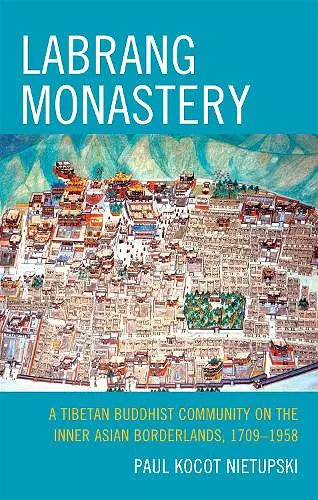Labrang Monastery
A Tibetan Buddhist Community on the Inner Asian Borderlands, 1709-1958
Format:Hardback
Publisher:Bloomsbury Publishing PLC
Published:9th Dec '10
Currently unavailable, and unfortunately no date known when it will be back

The Labrang Tibetan Buddhist Monastery in Amdo and its extended support community are one of the largest and most famous in Tibetan history. This crucially important and little-studied community is on the northeast corner of the Tibetan Plateau in modern Gansu Province, in close proximity to Chinese, Mongol, and Muslim communities. It is Tibetan but located in China; it was founded by Mongols, and associated with Muslims. Its wide-ranging Tibetan religious institutions are well established and serve as the foundations for the community's social and political infrastructures. The Labrang community's borderlands location, the prominence of its religious institutions, and the resilience and identity of its nomadic and semi-nomadic cultures were factors in the growth and survival of the monastery and its enormous estate.
This book tells the story of the status and function of the Tibetan Buddhist religion in its fully developed monastic and public dimensions. It is an interdisciplinary project that examines the history of social and political conflict and compromise between the different local ethnic groups. The book presents new perspectives on Qing Dynasty and Republican-era Chinese politics, with far-reaching implications for contemporary China. It brings a new understanding of Sino-Tibetan-Mongol-Muslim histories and societies. This volume will be of interest to undergraduate and graduate student majors in Tibetan and Buddhist studies, in Chinese and Mongol studies, and to scholars of Asian social and political studies.
One of the largest and most powerful institutions in Tibetan history, unique in its placement amid segmented territories ruled by several distinct inner Asian groups, Labrang Monastery has long been a site in need of critical study. Paul Kocot Nietupski's work brings us a thoroughly researched and sophisticated social and political history of Labrang Monastery. Drawing on a wide range of written and oral source material, Nietupski supplements a welcome survey of Amdo's religious and social structures with a careful study of the shifting social and political infrastructure underlying Labrang and its support communities. His examination of the spiritual and temporal authority of Labrang Monastery and the special forms of diplomacy needed for interaction with surrounding Manchu, Chinese, Mongol, and Muslim groups in this volatile region, makes a fundamental contribution to our knowledge of Asian history. -- Frances Garrett, University of Toronto
Labrang Tashikyil is one of the major Tibetan Buddhist monasteries and no contemporary Western scholar has researched its place in the Tibetan cultural world more deeply or more extensively than Paul Nietupski. This study is rich in detail in so many different areas. Labrang's history, economic structure, scholarly traditions, political role in the Tibetan Northeast, and much more are intricately described by Prof. Nietupski. He brings to the reader much that is new in the way of both information and insights. This is a most welcome volume... -- Elliot Sperling, Indiana University
Nietupski has provided us a fascinating snapshot on how multi-dimensional Buddhist monasteries can be and often were. The placement of the monastery in the frontier between Tibet and China, with significant Mongol and Muslim populations in the mix, reveals in detail the institutional, political and religious dynamics of the area. Far from the image of Buddhist monasteries as contemplative enclaves removed from society, Labrang is shown to be the major social force in its area of Chinese Central Asia. An excellent example of the intersection of written sources in Tibetan and Chinese with the oral histories that Nietupski secured during his lengthy fieldwork in Labrang. -- Ronald M. Davidson, Fairfield University
Labrang Tashikyil is one of the major Tibetan Buddhist monasteries and no contemporary Western scholar has researched its place in the Tibetan cultural world more deeply or more extensively than Paul Nietupski. This study is rich in detail in so many different areas. Labrang's history, economic structure, scholarly traditions, political role in the Tibetan Northeast, and much more are intricately described by Prof. Nietupski. He brings to the reader much that is new in the way of both information and
insights. This is a most welcome volume.
ISBN: 9780739164433
Dimensions: 240mm x 163mm x 26mm
Weight: 617g
306 pages